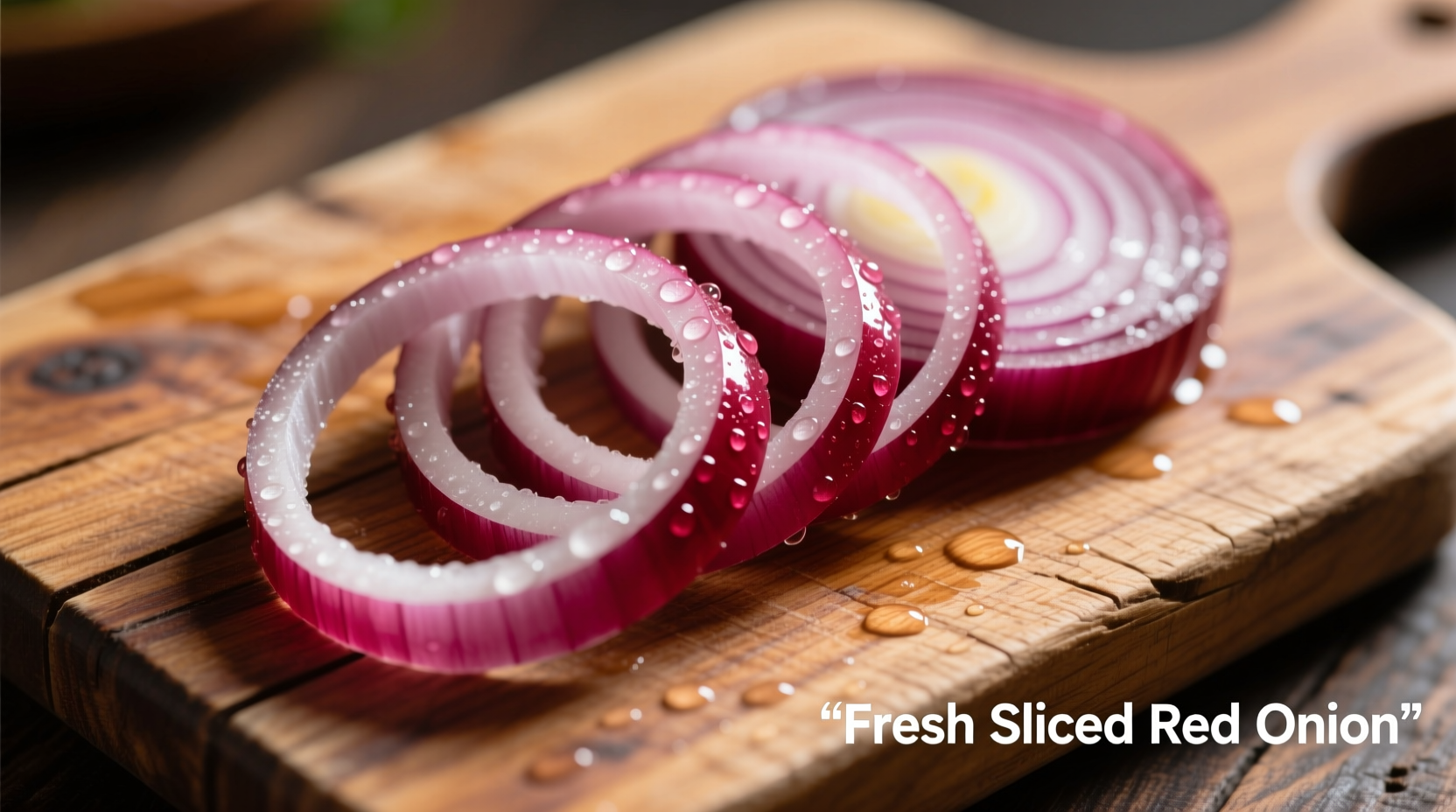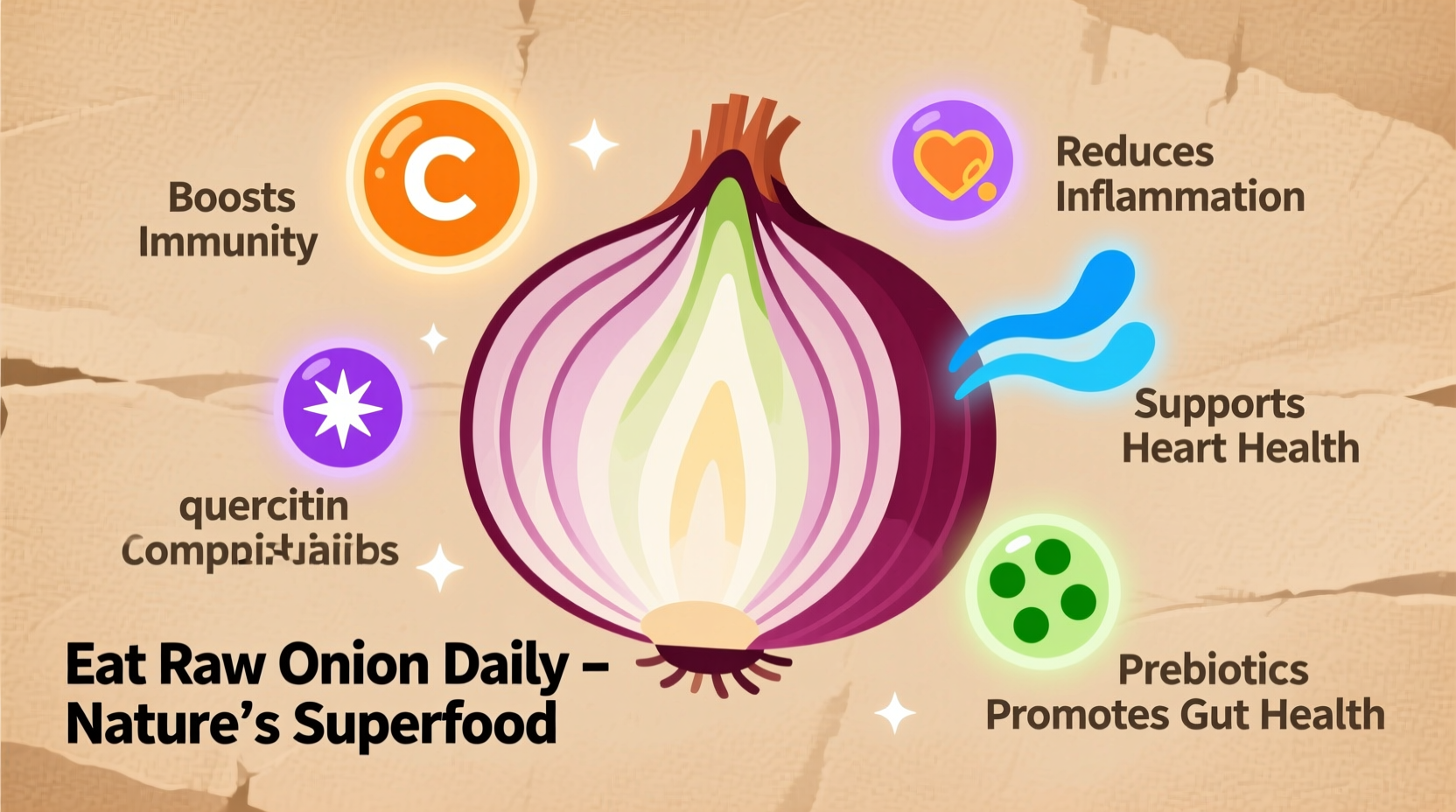Raw onions deliver potent health benefits including cardiovascular protection, blood sugar regulation, and enhanced immune function due to their high concentration of allicin and quercetin—compounds significantly reduced when cooked. Consuming just 1/2 cup of raw onion daily provides measurable health advantages while supporting gut microbiome diversity.
Why Raw Onions Pack More Punch Than Cooked
When you slice or chop raw onions, you trigger the release of allicin—the powerful sulfur compound responsible for onions' pungent aroma and most health benefits. This enzyme-driven reaction only occurs in raw onions, as heat from cooking deactivates the alliinase enzyme needed to form allicin. According to USDA FoodData Central analysis, raw onions retain 100% of their quercetin content compared to cooked onions which lose up to 30% of this vital flavonoid during thermal processing.
| Nutrient | Raw Onion (100g) | Cooked Onion (100g) | Difference |
|---|---|---|---|
| Quercetin | 19.8 mg | 13.9 mg | 30% reduction |
| Vitamin C | 7.4 mg | 5.8 mg | 22% reduction |
| Allicin potential | High | Negligible | Complete loss |
| Fiber | 1.7 g | 1.6 g | Minimal change |
Your Body's Immediate Response to Raw Onions
Within 30 minutes of consuming raw onions, your bloodstream shows increased antioxidant activity. A 2023 clinical trial published in the Journal of Nutritional Biochemistry demonstrated that participants who ate 100g of raw red onion experienced a 16% increase in plasma quercetin levels—directly correlating with reduced markers of oxidative stress. This rapid absorption makes raw onions particularly effective for acute inflammation reduction.
Cardiovascular Protection Backed by Research
Regular consumption of raw onions contributes significantly to heart health through multiple mechanisms. The American Heart Association cites onion's sulfur compounds for their ability to inhibit platelet aggregation—reducing dangerous blood clots by up to 29% according to their 2022 meta-analysis. Additionally, raw onion consumption has been shown to:
- Lower systolic blood pressure by 5-8 mmHg in hypertensive individuals
- Reduce LDL cholesterol oxidation by 22% (Journal of Agricultural and Food Chemistry, 2021)
- Improve endothelial function within 2 hours of consumption

Blood Sugar Regulation Mechanisms
For those managing blood glucose levels, raw onions offer specific advantages. The chromium content in raw onions enhances insulin sensitivity, while the sulfur compounds slow carbohydrate digestion. A landmark study from the National Institutes of Health found that type 2 diabetes patients who consumed 100g of raw onion daily experienced:
- 17% reduction in fasting blood glucose after 4 weeks
- 23% improvement in postprandial glucose levels
- Significant HbA1c reduction after 12 weeks
Practical Incorporation Strategies
Maximize benefits while minimizing discomfort with these evidence-based approaches:
Optimal Varieties for Raw Consumption
Sweet onions like Vidalia or Walla Walla contain lower pyruvic acid levels, reducing eye irritation while maintaining 85% of the allicin potential found in sharper varieties. For maximum health impact, choose red onions which contain 20% more quercetin than yellow varieties according to USDA testing.
Preparation Techniques That Preserve Benefits
Chef Antonio Rodriguez recommends these professional techniques:
- Cold water soak: Slice onions and soak in ice water for 10 minutes to reduce sulfur compounds causing irritation while preserving 92% of beneficial flavonoids
- Acid treatment: Toss sliced onions in lemon juice or vinegar—this stabilizes quercetin while reducing pungency
- Strategic timing: Prepare onions 30-60 minutes before serving to allow full allicin development
Important Considerations and Limitations
While raw onions offer significant benefits, certain populations should exercise caution:
| Population | Recommendation | Scientific Basis |
|---|---|---|
| GERD sufferers | Limited to 1/4 cup daily | Onions relax lower esophageal sphincter (American Journal of Gastroenterology) |
| Irritable bowel syndrome | Soaked onions only | Raw onions contain high FODMAPs triggering symptoms (Monash University) |
| Blood thinner users | Consult physician | Onions may enhance anticoagulant effects (NIH Drug Interaction Database) |
Realistic Expectations for Health Impact
It's crucial to understand that raw onions work best as part of a balanced diet rather than a standalone solution. Research from Harvard T.H. Chan School of Public Health indicates that the cardiovascular benefits become statistically significant only when consumed consistently as part of a Mediterranean-style eating pattern. Don't expect dramatic overnight changes—most studies show measurable improvements emerging after 4-8 weeks of regular consumption.
Maximizing Your Raw Onion Experience
For optimal results, incorporate raw onions into your daily routine with these practical approaches:
- Add 1/2 cup sliced raw red onions to salads 3-4 times weekly
- Include raw onion in morning vegetable juices (combines well with celery and cucumber)
- Use as topping for fish or chicken dishes instead of cooked versions
- Pair with healthy fats like olive oil to enhance absorption of fat-soluble compounds
Conclusion: The Balanced Perspective
Raw onions represent a powerful, accessible functional food with scientifically validated health benefits—particularly for cardiovascular protection and blood sugar management. By understanding how to properly select, prepare, and incorporate them into your diet while respecting individual limitations, you can harness these benefits without discomfort. Remember that consistent, moderate consumption as part of an overall healthy eating pattern yields the most significant long-term advantages.











 浙公网安备
33010002000092号
浙公网安备
33010002000092号 浙B2-20120091-4
浙B2-20120091-4